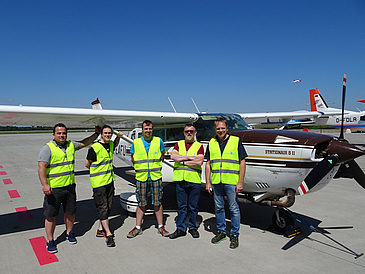In the project CoMet (Carbon Dioxide and Methane Mission), researchers from Berlin and Bremen not only work together with the DLR, but also closely with the AGH University of Science and Technology in Krakow and the Max Planck Institute for Biogeochemistry in Jena. The good weather in May was a stroke of luck for the researchers in the Upper Silesia coal district: “In addition to our equipment, we must also have sunshine for our measuring flights,” says the project leader, Heinrich Bovensmann from the Institute of Environmental Physics (IUP) at the University of Bremen. This is because the IUP research device cannot measure the methane values when the sky is cloudy. A Cessna aircraft provided by the Free University of Berlin will fly across the region for three weeks up to June 17, 2018. The first measuring flights took place successfully in the last week of May. Already on the second day, the team was able to coordinate flights with a total of four participating research aircrafts as well as mobile measurements on the ground – an important prerequisite for the subsequent analysis of the data.
Testing novel methods
Reducing global emissions of greenhouse gases requires their effective monitoring. The aim of the research flights in Poland is therefore to test novel methods for the determination of regional methane emissions using the Katowice region as an example. Data gathered from the various measuring systems – ground, aircraft and satellite sensors – are currently being collected to be later collated and provide a more detailed picture of methane emissions there. The Polish partners are active on site with ground-based measurements and they also establish contact with the coal mine operators.
Worldwide unique sensor
In the research aircraft provided by the Free University of Berlin, the University of Bremen uses its unique methane and CO2 sensor MAMAP (Methane Airborne MAPer). “MAMAP enables us to record the spatial distribution of methane,” says Bremen physicist KonstantinGerilowski, who developed MAMAP. Flight-meteorological experiences are essential for successful deployment and data interpretation. This expertise is present at the Free University of Berlin. “A special challenge for the ongoing measurement campaign is to be able to make precise temporal predictions regarding the currently prevailing cloud formation,” says Dr. Thomas Ruhtz, a research assistant at the Free University of Berlin. These meteorological predictions are important for the coordination of all ground- based and airborne measurements. The University of Bremen has been cooperating successfully for over ten years with the Free University of Berlin in the field of research flights for the measurement of air pollutants and greenhouse gases.
Part of a larger research project
The CoMet project is part of a larger research project: From mid-May to mid-June 2018, an experimental airborne mission under the direction of the German Aerospace Center (DLR) will measure the greenhouse gases carbon dioxide (CO2) and methane (CH4) over Europe. The German research aircraft HALO (High Altitude and Long Range Research Aircraft) equipped with innovative instruments for measuring greenhouse gases is also involved in the project. The Bremen and Berlin contribution to the CoMet project is funded by the German Research Foundation (DFG).
More information under:
https://www.dlr.de/dlr/en/desktopdefault.aspx/tabid-10081/151_read-27980/#/gallery/1725
http://www.iup.uni-bremen.de/deu/
https://userpage.fu-berlin.de/geoiss/de/home.html
www.uni-bremen.de
If you would like to know more about this topic, feel free to contact:
Dr. Heinrich Bovensmann
Institute for Environmental Physics (IUP)
Faculty of Physics/Electrical Engineering
University of Bremen
Email: Heinrich.Bovensmannprotect me ?!uni-bremenprotect me ?!.de (during the research flights in Poland)
Phone: +49 421 218 62102 (as of approx. June 18, 2018)
Dr. Thomas Ruhtz
Institute for Space Sciences
Faculty of Geosciences
Free University of Berlin
Email: ruhtzprotect me ?!zedat.fu-berlinprotect me ?!.de (during the research flights in Poland)
Phone: +49 30 49 30 838 56 662 (as of approx. June 18, 2018)
Dr. Andreas Fix
Institute of Atmospheric Physics
German Aerospace Center – Institute of Space Systems (DLR)
Phone: +49 81 53 282 -577
Email: andreas.fixprotect me ?!dlrprotect me ?!.de

